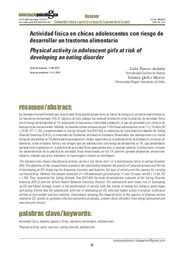Title:
Actividad física en chicas adolescentes con riesgo de desarrollar un trastorno alimentario |
Authors:
Pamies-Aubalat, Lidia 
QUILES, YOLANDA  |
Editor:
Col·legi Oficial de Psicòlegs de la Comunitat Valenciana |
Department:
Departamentos de la UMH::Ciencias del Comportamiento y salud |
Issue Date:
2019-12-30 |
URI:
https://hdl.handle.net/11000/31406 |
Abstract:
La literatura ha manifestado que la actividad física puede actuar como un factor de riesgo y/o un factor mantenedor en los trastornos alimentario (TA). El objetivo de este trabajo fue analizar la relación entre la práctica de actividad física con el riesgo de desarrollar un TA, analizando la frecuencia, intensidad y duración, el tipo de actividad y los motivos de realización de esa actividad. Método: la muestra estuvo compuesta por 1130 chicas adolescentes entre 11 y 19 años (M = 13.94; DT = 1.35); cumplimentaron el Eating Attitude Test (EAT-40), la subescala de insatisfacción corporal del Eating Disorder Inventory (EDI-2) y el Inventario de Conductas de Salud en Escolares. Resultados: Las adolescentes con menor riesgo de desarrollar un TA presentaron puntuaciones medias superiores en la realización de actividad con el motivo de divertirse, estar en buena forma y ver amigos que las adolescentes con riesgo de desarrollar un TA, que presentaron puntuaciones superiores en la práctica de actividad física para perder peso y quemar calorías. Conclusiones: conocer las características de la práctica de actividad física relacionada con los TA, permite generar propuestas preventivas eficaces, impedir que estos trastornos se mantengan e incluso se cronifiquen.
The literature has shown that physical activity can be a risk factor and / or a maintenance factor in eating disorders (ED). The objective of this research was to analyze the relationship between the practice of physical activity and the risk of developing an ED; Analyzing the frequency, intensity and duration, the type of activity and the reasons for carrying out that activity. Method: the sample consisted of 1130 adolescent girls between 11 and 19 years old (M = 13.94, SD = 1.35); They completed the Eating Attitude Test (EAT-40), the body dissatisfaction subscale of the Eating Disorder Inventory (EDI-2) and the School Health Behavior Inventory. Results: The adolescents with lower risk of developing an ED had higher average scores in the performance of activity with the motive of having fun, being in good shape and seeing friends that the adolescents with risk of developing an ED, who had higher scores in practice of physical activity to lose weight and burn calories. Conclusions: knowing the characteristics of the practice of physical activity related to ED, allows to generate effective preventive proposals, prevent these disorders from being maintained and even become chronic.
|
Keywords/Subjects:
actividad física
deporte
ejercicio físico
trastorno alimentario
adolescentes
physical activity
sport
exercise
eating disorder
adolescents |
Knowledge area:
CDU: Filosofía y psicología: Psicología |
Type of document:
application/pdf |
Access rights:
info:eu-repo/semantics/openAccess
Attribution-NonCommercial-NoDerivatives 4.0 Internacional |
DOI:
https://doi.org/10.14635/IPSIC.2019.118.7 |
Appears in Collections:
Artículos Ciencias del Comportamiento y Salud
|

.png)
